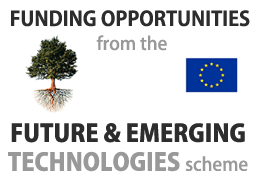|
"eMorph aims to profoundly innovate the computer vision field by introducing the concept of asynchronous event-driven computation. Such approach is a potential breakthrough in a discipline where frame-based synchronous approach is taken for granted, which will lead to the solution of yet unsolved problems intrinsic to the conventional machine vision approach. The project demonstrator “will deliver proofs-of-concept for” the radically new approach that we are developing."' The field of advanced robotics and in general of computer vision and sensorimotor control will vastly benefit from the achievements of eMorph. The new computational environment, unconstrained by the classical frame-based vision sensors and algorithms, brings specific benefits e.g. reduced quantity of data to transfer, store and process, simpler structure and more robust algorithms able to overcome problems of time-discretization, higher dynamic range, additionally, space-variance brings the advantage of scaling and rotation invariance, high resolution with large field of view and smaller number of pixels, reduced ambiguity with periodic patterns. The use of asynchronous event-based sensors leads to the design of new types of algorithms and computational strategies, that in turn can be morphed on silicon, exploiting the properties of adaptation, learning, self-calibration, high-parallelization that have been recently implemented on neuromorphic chips and systems.
eMorph will “help the neuromorphic chips leave the scientist desk” pushing towards the opening of the field to new horizons that can bring new challenges and then new ideas and improvements. Specifically, the eMorph framework posits specific application problems that require the development of new solutions and strategies that can improve the field in general, for example in terms of portability, robustness, power consumption and self-calibration that will be groundbreaking for future developments in autonomous robots. The project will bring neuromorphic electronic systems a step further towards consumer and industrial applications by proofing new robotic and vision processing concepts based on neuromorphic engineering with a robotic demonstrator. For example, the first year activity led to the definition of an open standard for a high speed serial address-event protocol and bus using COTS components, on which a large part of the neuromorphic community agreed that will further enable and simplify future projects and developments. Further, the research on event-driven algorithms for computer vision led to the design of a new sensor with more on-chip processing capabilities than currently available sensors. This will increase the capabilities of the sensor and its application possibilities in the field of robotic and artificial vision. The cross-fertilization among disciplines actively promoted by eMorph benefits all the disciplines and possibly will foster the birth and growth of a new scientific community that will pursue a deeper merging of the neuromorphic engineering approach to advanced robotics. The scientific and technological achievements expected from eMorph are crucial for many aspects of the European life. The industrial community has reached a very good standard in the development of information technology, communication and imaging devices. Nevertheless, there are major roadblocks that prevent the industrial approach to even get to a fraction of the capabilities of biological system in tasks involving interaction with the real-world in real-time. The reasons for this are not fully understood, but what is clear is that traditional digital computation and neural computation are based on completely different principles. Digital processors rely on high precision of their basic components, while neural computation performs extremely precise computation with inhomogeneous components that additionally change over time. The mechanisms of adaptation, homeostasis and plasticity make the system robust, fault tolerant and capable of extracting relevant information from noisy and ambiguous signals arising from the real world, and to produce appropriate behaviour in response to external stimuli. This profound difference in computation becomes more and more crucial as the technology is approaching to the resolution limit of the silicon substrate (transistor gates smaller than 30nm) in CMOS VLSI technology. As this limit is approached, transistors become unreliable and synchronization with a global clock becomes increasing more difficult. From this point of view, the asynchronous, massively parallel, and low-power technology of neuromorphic VLSI has obvious attractions that are only going to increase with the advent of sub-micron technologies in the coming years. Neuromorphic engineering is a growing field reaching good standards for industrial applications; a lot of effort, shared by eMorph, is on the development of circuitry for easy calibration of the dedicated hardware, and the effort of developing self-calibration systems, to make the technology accessible to off-the shelf users. The main eMorph effort towards this direction is on the development of interfacing technology for exploitation of neuromorphic systems on general purpose hardware, accomplished with both dedicated digital hardware and open-source software. The further development of this topic and of research on vision sensors, extended to space-variant topology, will advance the expertise of the participants, keeping the leading position of Europe in the neuromorphic sensors research community, one of the worldwide hot topics.
|

